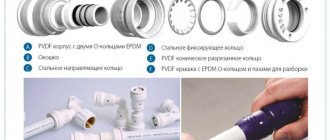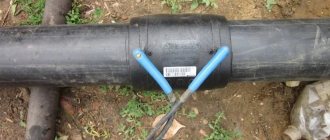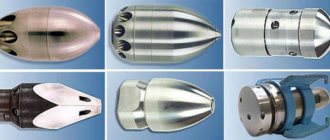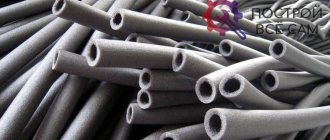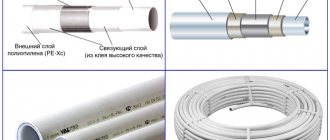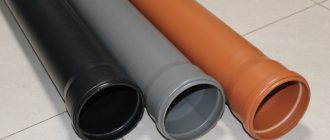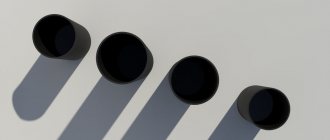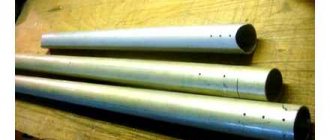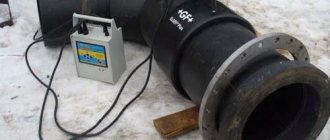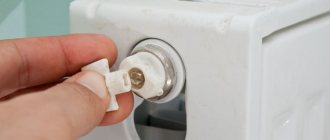Modern polymer materials used for the manufacture of pipes have practically replaced steel pipelines in households; when laying highways, special methods and technologies are used to change the configuration of the line and increase its length. The connecting coupling for pipes is designed for tight and durable mating of joints in straight sections; for effective operation, its technical characteristics must correspond to the parameters of the main line.
Unlike industrial connections using soldering, welding, flanges, the pipe coupling is most widely used in the installation of cold and hot water supply lines, sewerage, and heating in individual construction. Thanks to modern developments, it has become possible to lay communications from popular materials: cross-linked metal plastic (PE-X) and low-density polyethylene (HDPE) without the use of complex technical processes and specialized construction tools.
If you know the rules for installing pipeline systems, any homeowner can install a polymer pipeline with their own hands (with the exception of polypropylene, where soldering is required) using different types of fittings - this will save significant financial resources if necessary.
Rice. 1 Push coupling for pipes - appearance and design
What is a pipe coupling?
A coupling is a type of fitting, designed to combine pipelines in straight sections; it is a short cylindrical part with a design that allows the connected elements to be securely and hermetically fixed inside its body.
All coupling fittings and adapters are designed to fix the outer surface; support fittings are usually located inside, to which the inner pipe casing is pressed. Depending on the material of the pipes, different types of couplings are used to connect them:
- steel products - connected with threaded fittings,
- polypropylene - by soldering,
- metal-plastic (cross-linked polyethylene) and low-density polyethylene - joined with compression fittings.
In the construction field, when underground pulling polyethylene communications, to obtain a high-strength and reliable joint, the ends are connected with electric welded couplings.
The latest breakthrough in technology has been the creation of push fittings, which are an alternative to compression crimp types. It should be noted that such coupling is easy to install - the pipe is permanently connected to the fitting by inserting into the fitting until it clicks; this process takes 1 - 2 seconds.
Manufacturing of electric welded coupling
The electrofusion coupling is manufactured using a method such as high-pressure injection molding. The production process takes very little time, but requires preliminary preparation of molds in order to cast couplings of a certain configuration and size. The dispensing module is filled with the required amount of molten polymer. A nozzle under pressure injects the molten mass into the prepared mold. The cooled polymer mass takes on the specified dimensions and configuration and turns into a ready-made connection for pipelines.
The coupling made in this way is placed in a plastic package, supplemented with a bar code. It can be included in the package in the form of a separate card or sticker attached directly to the coupling. The barcode records important information about the welding parameters for a special electrofusion welding machine, setting its operating program.
It is important to know! To start the device you will need a scanner or reading pencil.
Types of coupling connections
When laying communications in the household, situations often arise when it is necessary to connect elements from different materials; in this case, couplings with different transitions are used.
The most common option for a combined coupling fitting is the transition to internal or external threads for connecting pipes made of other materials or engineering equipment, plumbing fittings (faucets, stopcocks, heated towel rails).
It is often necessary to switch from one diameter to another from one material - such transition fittings are also commercially available.
Rice. 2 Adapter couplings for threads and for soldering polypropylene
Threadless couplings for soldering and welding
A distinctive feature of threadless couplings is the ability to join pipes of equal or different diameters at their joints. There are two main technologies for connecting threadless couplings - by soldering (welding) or by crimping a pipe (compression or push couplings).
To solder polypropylene, soldering irons for polypropylene pipes with heating nozzles are used, which heat the inside of the fitting and the outer pipe surface - after a short heating time, the molten sections are joined and allowed to cool for some time, after which a hermetically sealed joint is obtained.
Soldering technology is also used for the installation of large-diameter HDPE pipelines in the construction and industrial sectors, using expensive program-controlled equipment.
The joining procedure consists of several sequential operations, including trimming (aligning the ends in a vertical plane), heating the edges to be joined with a disk iron and joining them under pressure using a hydraulic jack.
In the construction industry, the joining of gas and water HDPE pipes is also carried out using electric welded couplings, into which two joined sections are inserted. The design is a polyethylene cylinder with a heating coil inside, the contacts of which are brought out. Electrofusion welding is performed by an electronic device, which is connected to the output contacts, it reads the bar code and, according to its readings, the automatic device produces the required voltage (current) for a certain time.
Rice. 3 Connecting coupling for combined type water supply pipes
Combination threaded couplings
The use of a combined coupling, in which the outlet pipes are designed to connect various types of pipes, is widespread in households. In this way, steel pipes are connected to polypropylene and all types of polyethylene - low pressure, cross-linked polyethylene and metal-plastic.
Often there is an option when the coupling has a crimp (press) connection to a polymer pipeline, and the other part of the nozzle is equipped with a thread intended for connection to metal pipes, shut-off valves or fittings.
American split couplings
The advantage of the American type is the ability to install a collapsible unit at the junction of pipes with various engineering equipment, for example, heating radiators, circulation pumps, and collector units.
Almost all types of pipes, steel, polypropylene, metal-plastic, as well as pipes made of cross-linked polyethylene, have American ones.
Structurally, the American one has on one side a part connecting it to the pipe, on the other side a nut screwed onto the coupling and a transition to an external or internal thread. The tightness of the connection of the detachable part is ensured by a rubber ring.
Rice. 4 Combined American pipes
Tools and accessories for installation
To install a pipeline using electric welded fittings, you will need the following tools:
- for cutting pipes - a pipe cutter or a hacksaw;
- sharp knife + sandpaper or bevel remover for cleaning the cut from burrs and irregularities;
- acetone or organic solvent, rags for removing dust and degreasing the joint.
The welding process itself requires a certain current to be supplied to the terminals. For this, a professional welding transformer is used. It belongs to expensive special equipment. For installation of individual communications, such an electricity transformer can be rented.
We recommend that you read: Which gas torch to choose for soldering copper pipes - a review of the best
The welding machine is easily adjusted to the required voltage. In most modern welders for polymer materials, the settings are carried out automatically, according to the barcode on the electric welding fitting. Advanced models read information directly from the coupling terminals.
Connecting coupling for plastic pipes
Plastic products are widely used in individual construction and currently completely replace not only steel pipeline communications, but also many types of fittings, and for connecting HDPE in everyday life, plastic is the main component.
In a private house, a polymer pipeline made of cross-linked polyethylene and metal-plastic operates in heating systems, underfloor heating, hot and cold water supply. Ordinary polypropylene and its varieties (reinforced with fiberglass or PP-R aluminum) are widely used for heating and supplying hot and cold water to the house.
Internal sewage systems are installed from polyvinyl chloride (PVC) polymers, and outdoor sewer pipes (orange) are made from unplasticized polyvinyl chloride (UPVC).
Water pipes made of low-pressure polyethylene (HDPE pipes) are used to supply cold water to the house; in the industrial sector, polyethylene is a material for outdoor sewer lines and for laying gas lines.
In all the above examples, for domestic use, joining is carried out using couplings; special equipment is required for soldering polypropylene or installing press fittings.
Rice. 5 Compression coupling for HDPE pipes
Compression and press couplings for HDPE and metal-plastic PEX
HDPE pipes are used to organize individual water supply; they are used to supply water to a house from a well or a well, if the water intake is carried out by a submersible electric pump or station located in a caisson.
A solid line is laid underground without breaks, the water supply is connected only at the exit from the well and the entrance to the house, very often a polyethylene section is used as a pressure line and is connected to an electric pump, removed from the well head.
In all of the above cases, pipes are connected using plastic fittings; the peculiarities of their installation with a coupling are that they not only connect pipe sections, but also ensure their connection to the equipment.
Metal-plastic is also connected in a similar way, taking into account that a crimp connection on a union nut is not a very reliable method - a nut without a spring ring is subject to self-unscrewing and over time (after 5 - 7 years) a small leak may appear. Therefore, this technology is used only when the line is located externally in the area of visibility and direct access - if drops are detected at the junction, you can always tighten the nut.
Disadvantages of an electric welded coupling
Speaking about the disadvantages of electric welded couplings, we are talking, rather, about the features of their use and limitations. Electric welded connections cannot be used if:
- the temperature regime goes beyond the operating range from 0º to 40º C. That is, their installation in hot water supply systems should be excluded in order to prevent leaks;
- contact with an alkaline or strongly acidic environment occurs;
- the operating pressure exceeds that recommended for this type of coupling (more than 16 atm).
The disadvantages of the electric welded coupling also include its considerable cost. But the costs of purchasing such a connection are compensated by the durability of its operation, the insignificance of labor costs for a specialist invited for installation (or their complete absence if installed independently).
Couplings are mounted only using a special welding machine; there is no other method of connecting these fittings to pipes
Steel pipe couplings
Connections for steel pipes come in several varieties; the simplest is a cylinder made of steel, cast iron, stainless steel or brass with an internal thread.
The disadvantage of this type is the need to rotate one of the sections of the connected pipe around its axis, so this type is used only when working with short sections.
To transition from internal to external threads, fittings are widely used - types of threaded fittings made in the form of a hex nut or bushing with a small diameter internal thread and a larger external thread.
Rice. 10 Couplings for metal and fittings
To join the ends of fixed pipes in a line, the following types of connections are used:
Sgon. The product is a piece of pipe with a double-sided external thread of different lengths; to connect the pipe ends, the bend is screwed into the pipe with a short thread, and the other end is connected using a coupling placed on the long threaded section. The coupling is screwed onto the external thread of the connected pipe and secured with a lock nut, wrapping a thick layer of tow into the place of fixation.
Compression coupling. Gebo couplings operate on the principle of metal-plastic compression fittings; their design includes a clamping ring with a slot, which is tightened with a union nut. Unlike fittings for cross-linked polyethylene, where the ring compresses and tightly seals the plastic polymer surface, in a metal product due to its rigidity this is not possible, so the Gebo design additionally includes a rubber sealing ring.
Rice. 11 Coupling for Gebo pipes
Cast iron couplings for sewerage
When sewer pipes are made of cast iron, they are connected using a socket joint in the same way as PVC sewer pipes; a typical coupling is a piece of pipe with double-sided sockets. This type of coupling joint is sealed with rubber rings or caulking - the old-fashioned method, when hemp or flax rope impregnated with bitumen is pushed into the joint gap and then covered with cement mortar.
Device
The design of the welded coupling includes the following components:
- body - in the form of a thick-walled short pipe made of black polyethylene;
- heating cores (2 pcs.) - have the shape of a spiral made of metal wire (nichrome), pass through the body of the device in such a way as to heat the material in the area where the parts are joined to the melting temperature as efficiently as possible. The spirals are connected to each other in series and have high electrical resistance;
- terminal leads are the free ends of each spiral, brought out from both sides of the product. A heating apparatus is connected to them to supply electric current;
- welding indicator - not every modification of the fitting has it;
- fasteners - used to secure the coupling in its working position.
Features of installation of couplings for various types of pipes
To install most couplings, no special tool is required; one or two adjustable wrenches are enough; to seal joints in metal products, you will need flax tow or plumbing thread, fum tape for plastic threads. To fasten polypropylene pipes or install press fittings, you will need a special tool and some skills; if you do the work yourself, it is easier to rent the necessary equipment from a construction tool rental.
Rice. 12 Installation of plastic sewer pipes
Sleeve compression connection
Crimp compression couplings are dismountable connections; their installation does not require specialized tools (except for two wrenches); the process of joining with a metal-plastic pipe includes the following operations:
- Prepare the end of the pipe for installation of the coupling fitting; to do this, cut it at an angle of 90 degrees to the axis with scissors and insert a calibrator inside, turning it slightly to expand the seat.
- Place a nut and a ring with a slot on the pipe, insert the fitting body fitting inside it, and move the ring with the clamping nut to the end of the body.
- One wrench holds the fitting body, the other screws the clamping nut.
Tips for choosing
The choice of electric welded couplings should be based on the characteristics of the polyethylene pipes being connected. To mark them, several numbers of Russian and English letters are used. The three letters SDR are an abbreviation for the phrase Standard Dimension Ratio, which is translated into Russian as: Standard Dimension Ratio. The number behind it is the result of dividing the outer diameter of the pipe by the wall thickness. The numbers following the PE symbol indicate the type of polymer.
Today, the most popular pipe products made from HDPE are labeled PE100SDR17. It has uniquely high strength, which provides these products with increased reliability during operation. In order not to reduce it, experts advise using electric couplings to connect PE100SDR17 pipes. Moreover, it is better to purchase products from world famous brands:
- Italian companies Chiorino or Nupigeco;
- German company Optibelt;
- companies from Holland - Ammeraal Beltech.
The products of Russian companies have good quality - TrubOptPlast (Moscow), Avant-invest, LLC (Ekaterinburg), TyumenPlus, LLC and so on.
To connect pipeline branches made of polyethylene products, the use of electric couplings and tees from these manufacturers will be the best solution.
Features of weldless groovelock joints
The groovelock system of weldless connections for metal pipes is essentially clamps made of ductile cast iron with an elastic cuff made of antibacterial EPDM rubber. Elements (tees, crosses, adapters, flanges, plugs, etc.) are fixed using grooves at the ends that fit into special knurled grooves on the pipes.
A rubber gasket is installed over the two ends of the pipe, and a two-piece coupling is placed around it, which is tightened with two bolts and nuts. When tightening the bolts, pressure is created, imparting deformation to the seal. The rubber cuff fits tightly to the pipe, ensuring tightness and strength. Joining grooves and grooves provides additional connection.
Gasket tightness
The C-shaped profile of the rubber gasket creates an airtight seal due to three factors:
- The diameter of the gasket is smaller than the diameter of the pipe, which creates a seal in the assembly;
- Full adaptation of the gasket with the coupling halves, which enhances the seal;
- Increasing the pressure when tightening the bolts makes the connection 100% sealed.
Cast iron pipe fittings
The connection of cast iron pipes can be made in two different ways:
- using a coupling on which rubber seals are installed. The installation of such a connection is practically no different from the assembly of a plastic sewer system;
Couplings for cast iron fittings
- Using the technology of caulking joints, a drawing diagram of such a connection is shown in the figure.
Drawing diagram of embossing joints of cast iron pipe fittings
Features of installation using this technology require a little explanation of the process :
- to make such a connection, it is necessary to provide full access to any part of the structure being installed. Problems may arise when the installation is carried out close to the wall, in which case it will be necessary to hollow out part of it;
- The joint is stamped using a special sealant - a heel. It is an organic fiber that is impregnated with oil;
GEBO coupling assembly diagram
Before installing the Gebo coupling on a pipe, it is necessary to carry out preparatory work. The installation diagram is simple, but for the first attempts it is recommended to use “training” pipes. You can install and remove the connector several times. After intermediate installation, if possible, check the tightness of the joint. Only after this can you begin the main installation process.
Installation stages
Gebo installation procedure.
- Install the clamping nut onto the pipe.
- Install the clamping ring on the pipe, and then the clamping and sealing ring.
- Insert the pipe into the housing, but not all the way. There should be a gap of 1-1.5 mm.
- Tighten the clamping nut using a pipe wrench or open-end wrench.
- Connect the threaded part to the other side of the line.
During installation, it is necessary to control the position of the connector. Its longitudinal axis must coincide with the direction of the pipeline. Otherwise, a slight distortion will create a “threshold” for the working fluid in this section of the line, which will affect its speed and pressure.
How does installation occur using electric welded parts?
Installation work is carried out by supplying electric current to the heating part, which is found in couplings with built-in heating parts. A subsequent increase in temperature allows the internal walls of the product and part of the pipeline to be soldered, as a result of which a boundary is formed that has complete sealing and high-quality soldering of the material.
The installation itself using fittings includes the following items:
- from the very beginning, the pipe that needs to be connected to the overall structure is cut clearly at a right angle. It is strictly forbidden to leave any unevenness or roughness. After an even cut, the product is cleaned of adhering dirt;
- Next, the cut area is carefully cleaned with a special technical tool. In this case, the diameter for the entrance to the electric welded fitting is observed. Afterwards, all connecting parts must be degreased, for which use a piece of clean cloth with acetone or other solvent applied to it;
- The sides intended for welding are carefully fixed in the fasteners. Some modifications of the fittings already contain these fasteners, into which the ends of the polyethylene pipes are then inserted. We must not forget that the distance between the welded pipes located in the middle of the coupling should in no way exceed the thickness of the walls of the polyethylene pipe ;
- Welding work is carried out with a soldering machine for sequential joining of pipes. Welding takes place automatically; the smart device can independently set the temperature appropriate for this type of welding, in addition, set the voltage percentage and welding time limit. During the process, the welding terminals are connected to the contacts of the electric welding section, and all information from the barcode is automatically transferred. All electric welded couplings have this code;
- As soon as the welding work is completed, the joints are immediately checked. They must be completely sealed. To check, the joints are soaped and then compressed air is supplied through the pipe.
In order for the installed system to serve for a long period of time, the work must be carried out by qualified craftsmen. If you use electric welded couplings in the process, designed specifically for polyethylene pipelines, then the result is a strong and monolithic structure.
electric welding coupling sdr17
In what areas are electric welded couplings used?
Due to the fact that the installation of such connections is carried out quite quickly, they are simply irreplaceable during emergency and emergency work. If it is impossible to use other elements during butt welding in the construction of a pipeline of increased complexity, couplings are used. And the built-in spiral in electric-welded couplings makes it possible to carry out installation in difficult conditions, for example, trenches.
We recommend: How to correctly bend a profile pipe with your own hands at home without a pipe bender: video
Electric welding coupling PE100 SDR17 Working pressure: 6 bar Gas - 10 bar Water SDR 17 Polyethylene type: PE100
